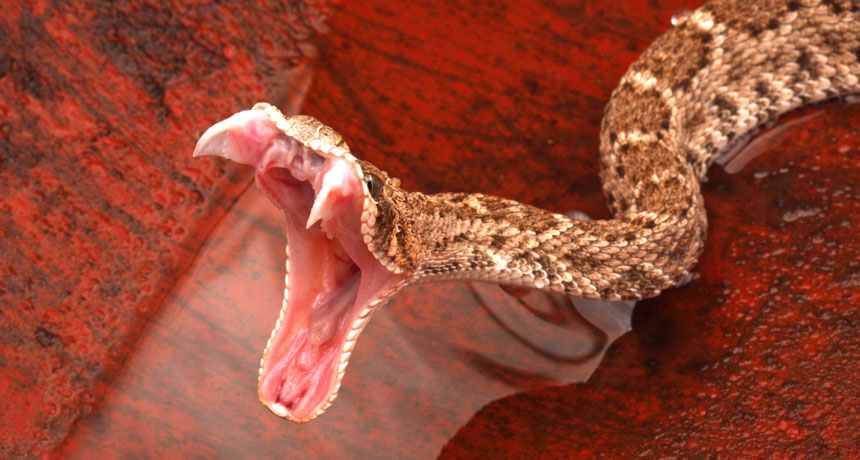
STILL A FRIGHTFUL BITE The venom of the western diamondback rattlesnake (shown here) isn’t neurotoxic — but its ancestor’s was. A loss of genes 4 million to 7 million years ago narrowed the range of toxins this and some other rattlers can use to kill prey.
Audrey Snider-Bell/Shutterstock
- More than 2 years ago
Modern rattlesnakes have pared down their weaponry stockpile from their ancestor’s massive arsenal. Today’s rattlers have irreversibly lost entire toxin-producing genes over the course of evolution, narrowing the range of toxins in their venom, scientists report September 15 in Current Biology.
“After going through all the work of evolving powerful toxins, over time, some snakes have dispensed with them,” says study coauthor Sean B. Carroll, an investigator with the Howard Hughes Medical Institute who is at the University of Wisconsin–Madison. These modern rattlesnakes produce smaller sets of toxins that might be more specialized to their prey.
Carroll, an evolutionary biologist, and his colleagues focused on a family of enzymes called phospholipase A2, or PLA2. Genes in the PLA2 family are one of the main sources of toxic proteins in the deadly cocktail of rattlesnake venom. This set of genes can be shuffled around, added to and deleted from to yield different collections of toxins.
Data from the genome — the complete catalog of an organism’s genetic material — can reveal how those genetic gymnastics have played out over time. Carroll’s team looked at the relevant genome regions in three modern rattlesnake species (western diamondback, eastern diamondback and Mojave) and also measured molecules that help turn genetic instructions into proteins. That showed not just how the genes were arranged, but which genes the snakes were actually using. Then, the scientists blended that data with genetic information about other closely related rattlesnakes to construct a potential evolutionary story for the loss of PLA2 genes in one group of snakes.
The most recent common ancestor of this group probably had a large suite of PLA2 genes 22 million years ago, the scientists found. That collection of genes, which probably came about through many gene duplications, coded for toxins affecting the brain, blood and muscles of the snake’s prey. But 4 million to 7 million years ago, some rattlesnake species independently dropped different combinations of those genes to get smaller and more specialized sets of venom toxins. For instance, three closely related rattlesnake species in the group lost the genes that made their venom neurotoxic.
“The surprise is [the genes’] wholesale loss at two levels: complete disappearance from the venom and complete disappearance from the genome,” Carroll says. In other words, some of the genes are still lurking in the genome but aren’t turned on. The proteins those genes produce don’t show up in the venom in modern snakes. But other genes have left the genome entirely — a more dramatic strategy than simple changes in gene regulation.
Environmental shifts might have encouraged this offloading of evolutionary baggage, Carroll says. If a certain snake species’ main food source stopped responding to a neurotoxin, the snake would waste energy producing a protein that didn’t do anything helpful.
Plus, a rattlesnake doesn’t just invest in producing venom. It also needs to produce antibodies and other proteins to protect itself from its own poison, says Todd Castoe, an evolutionary biologist at the University of Texas at Arlington who wasn’t involved in the study. As a snake’s weapon becomes more complex, its shield does too — and that protection can use up resources.
Researchers also found that venom genes might not be consistent even within a single species of rattlesnake, perhaps because snakes in different areas specialize in different prey. One western diamondback rattlesnake that Carroll’s team sampled had unexpected extra genes that the other western diamondbacks didn’t have. His lab is currently looking into these within-species differences in venom composition to see how dynamic the PLA2 genome region still is today.
As for the ancestral rattlesnake, it’s impossible to say exactly how powerful the now-extinct reptile’s venom was, Carroll says. But the wider variety of enzymes this rattlesnake could hypothetically produce would have given it more flexibility to adapt its poison to environmental curveballs — an ability that Castoe describes as “the pinnacle of nastiness.”
Editor’s note: Sean B. Carroll is on the board of trustees of Society for Science & the Public, which publishes Science News.






